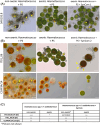Importance, structure, cultivability, and resilience of the bacterial microbiota during infection of laboratory-grown Haematococcus spp. by the blastocladialean pathogen Paraphysoderma sedebokerense: evidence for a domesticated microbiota and its potential for biocontrol
- PMID: 39832809
- PMCID: PMC11797010
- DOI: 10.1093/femsec/fiaf011
Importance, structure, cultivability, and resilience of the bacterial microbiota during infection of laboratory-grown Haematococcus spp. by the blastocladialean pathogen Paraphysoderma sedebokerense: evidence for a domesticated microbiota and its potential for biocontrol
Abstract
Industrial production of the unicellular green alga Haematococcus lacustris is compromised by outbreaks of the fungal pathogen Paraphysoderma sedebokerense (Blastocladiomycota). Here, using axenic algal and fungal cultures and antibiotic treatments, we show that the bacterial microbiota of H. lacustris is necessary for the infection by P. sedebokerense and that its modulation affects the outcome of the interaction. We combined metagenomics and laboratory cultivation to investigate the diversity of the bacterial microbiota associated to three Haematococcus species and monitor its change upon P. sedebokerense infection. We unveil three types of distinct, reduced bacterial communities, which likely correspond to keystone taxa in the natural Haematococcus spp. microbiota. Remarkably, the taxonomic composition and functionality of these communities remained stable during infection. The major bacterial taxa identified in this study have been cultivated by us or others, paving the way to developing synthetic communities to experimentally explore interactions within this tripartite system. We discuss our results in the light of emerging evidence concerning the structuring and domestication of plant and animal microbiota, thus providing novel experimental tools and a new conceptual framework necessary to enable the engineering of Haematococcus spp. microbiota toward the biocontrol of P. sedebokerense.
Keywords: Chlorophyta; domestication; fungal pathogen; green alga; metagenomics; microbiome.
© The Author(s) 2025. Published by Oxford University Press on behalf of FEMS.
Conflict of interest statement
None declared.
Figures









Similar articles
-
A new flagellated dispersion stage in Paraphysoderma sedebokerense, a pathogen of Haematococcus pluvialis.J Appl Phycol. 2016;28:1553-1558. doi: 10.1007/s10811-015-0700-8. Epub 2015 Oct 18. J Appl Phycol. 2016. PMID: 27226700 Free PMC article.
-
Paraphysoderma sedebokerense GlnS III Is Essential for the Infection of Its Host Haematococcus lacustris.J Fungi (Basel). 2022 May 25;8(6):561. doi: 10.3390/jof8060561. J Fungi (Basel). 2022. PMID: 35736044 Free PMC article.
-
Natural Communities of Carotenogenic Chlorophyte Haematococcus lacustris and Bacteria from the White Sea Coastal Rock Ponds.Microb Ecol. 2020 May;79(4):785-800. doi: 10.1007/s00248-019-01437-0. Epub 2019 Nov 1. Microb Ecol. 2020. PMID: 31676992
-
An ultrastructural study of Paraphysoderma sedebokerense (Blastocladiomycota), an epibiotic parasite of microalgae.Fungal Biol. 2016 Mar;120(3):324-37. doi: 10.1016/j.funbio.2015.11.003. Epub 2015 Dec 1. Fungal Biol. 2016. PMID: 26895861
-
Culturing the human microbiota and culturomics.Nat Rev Microbiol. 2018 May 1;16:540-550. doi: 10.1038/s41579-018-0041-0. Nat Rev Microbiol. 2018. PMID: 29937540 Review.
References
-
- Abdul Malik SA, Bedoux G, Garcia Maldonado JQ et al. Defence on surface: macroalgae and their surface-associated microbiome. In: Advances in Botanical Research. Amsterdam: Elsevier, 2020, 327–68. 10.1016/bs.abr.2019.11.009. - DOI
-
- Allewaert CC, Hiegle N, Strittmatter M et al. Life history determinants of the susceptibility of the blood alga Haematococcus to infection by Paraphysoderma sedebokerense (Blastocladiomycota). Algal Res. 2018;31:282–90. 10.1016/j.algal.2018.02.015. - DOI
-
- Allewaert CC, Vanormelingen P, Pröschold T et al. Species diversity in European Haematococcus pluvialis (Chlorophyceae, Volvocales). Phycologia. 2015;54:583–98. 10.2216/15-55.1. - DOI
MeSH terms
Grants and funding
LinkOut - more resources
Full Text Sources
Miscellaneous

